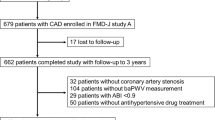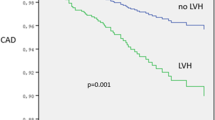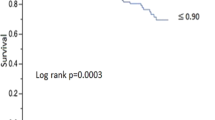Abstract
Aortic stiffness, measured by carotid-femoral pulse wave velocity (PWV), is a predictor of cardiovascular (CV) mortality in patients with end-stage renal disease (ESRD). Aortic stiffness increases aortic systolic and pulse pressures (cSBP, cPP) and augmentation index adjusted for a heart rate of 75 beats per minute (AIx@75). In this study, we examined if the integration of multiple components of central blood pressure and aortic stiffness (ICPS) into risk score categories could improve CV mortality prediction in ESRD. In a prospective cohort of 311 patients with ESRD on dialysis who underwent vascular assessment at baseline, 118 CV deaths occurred after a median follow-up of 3.1 years. The relationship between hemodynamic parameters and CV mortality was analyzed through Kaplan–Meier and Cox survival analysis. ICPS risk score from 0 to 5 points were calculated from points given to tertiles, and were regrouped into three risk categories (Average, High, Very-High). A strong association was found between the ICPS risk categories and CV mortality (High risk HR = 2.20, 95% CI: 1.05–4.62, P = 0.036); Very-High risk (HR = 4.44, 95% CI: 2.21–8.92, P < 0.001) as compared to the Average risk group. The Very-High risk category remained associated with CV mortality (HR = 3.55, 95% CI: 1.37–9.21, P = 0.009) after adjustment for traditional CV risk factors as compared to the Average risk group. While higher C-statistics value of ICPS categories (C: 0.627, 95% CI: 0.578–0.676, P = 0.001) was not statistically superior to PWV, cPP or AIx@75, the use of ICPS categories resulted in a continuous net reclassification index of 0.56 (95% CI: 0.07–0.99). In conclusion, integration of multiple components of central blood pressure and aortic stiffness may potentially be useful for better prediction of CV mortality in this cohort.
This is a preview of subscription content, access via your institution
Access options
Subscribe to this journal
Receive 12 digital issues and online access to articles
$119.00 per year
only $9.92 per issue
Buy this article
- Purchase on Springer Link
- Instant access to full article PDF
Prices may be subject to local taxes which are calculated during checkout


Similar content being viewed by others
Data availability
The datasets analyzed during the current study are available from the corresponding author upon reasonable request.
References
Foley RN, Parfrey PS, Sarnak MJ. Epidemiology of cardiovascular disease in chronic renal disease. J Am Soc Nephrol. 1998;9:S16–23.
Go AS, Chertow GM, Fan D, McCulloch CE, Hsu CY. Chronic kidney disease and the risks of death, cardiovascular events, and hospitalization. N Engl J Med. 2004;351:1296–305.
Parfrey PS, Foley RN. The clinical epidemiology of cardiac disease in chronic renal failure. J Am Soc Nephrol. 1999;10:1606–15.
Blacher J, Guerin AP, Pannier B, Marchais SJ, London GM. Arterial calcifications, arterial stiffness, and cardiovascular risk in end-stage renal disease. Hypertension. 2001;38:938–42.
Blacher J, Guerin AP, Pannier B, Marchais SJ, Safar ME, London GM. Impact of aortic stiffness on survival in end-stage renal disease. Circulation. 1999;99:2434–9.
Pannier B, Guérin AP, Marchais SJ, Safar ME, London GM. Stiffness of capacitive and conduit arteries: prognostic significance for end-stage renal disease patients. Hypertension. 2005;45:592–6.
Baumann M, Wassertheurer S, Suttmann Y, Burkhardt K, Heemann U. Aortic pulse wave velocity predicts mortality in chronic kidney disease stages 2-4. J Hypertens. 2014;32:899–903.
Utescu MS, Couture V, Mac-Way F, De Serres SA, Marquis K, Larivière R, et al. Determinants of progression of aortic stiffness in hemodialysis patients: a prospective longitudinal study. Hypertension. 2013;62:154–60.
Van Bortel LM, Laurent S, Boutouyrie P, Chowienczyk P, Cruickshank JK, De Backer T, et al. Expert consensus document on the measurement of aortic stiffness in daily practice using carotid-femoral pulse wave velocity. J Hypertens. 2012;30:445–8.
London GM, Blacher J, Pannier B, Guérin AP, Marchais SJ, Safar ME. Arterial wave reflections and survival in end-stage renal failure. Hypertension. 2001;38:434–8.
Safar ME, Blacher J, Pannier B, Guerin AP, Marchais SJ, Guyonvarc'h PM, et al. Central pulse pressure and mortality in end-stage renal disease. Hypertension. 2002;39:735–8.
Matschkal J, Mayer CC, Sarafidis PA, Lorenz G, Braunisch MC, Guenthner R, et al. Comparison of 24-hour and office pulse wave velocity for prediction of mortality in hemodialysis patients. Am J Nephrol. 2019;49:317–27.
Sarafidis PA, Persu A, Agarwal R, Burnier M, de Leeuw P, Ferro CJ, et al. Hypertension in dialysis patients: a consensus document by the European Renal and Cardiovascular Medicine (EURECA-m) working group of the European Renal Association-European Dialysis and Transplant Association (ERA-EDTA) and the hypertension and the kidney working group of the European Society of Hypertension (ESH). Nephrol Dial Transpl. 2017;32:620–40.
Nemcsik J, Tabák Á, Batta D, Cseprekál O, Egresits J, Tislér A. Integrated central blood pressure-aortic stiffness risk score for cardiovascular risk stratification in chronic kidney disease. Physiol Int. 2018;105:335–46.
Batta D, et al. Integrated central blood pressure-aortic stiffness risk categories and cardiovascular mortality in end-stage renal disease. Artery Res. 2019;25:49–55.
Mattu GS, Perry TL Jr, Wright JM. Comparison of the oscillometric blood pressure monitor (BPM-100(Beta)) with the auscultatory mercury sphygmomanometer. Blood Press Monit. 2001;6:153–9.
Asmar R, Benetos A, Topouchian J, Laurent P, Pannier B, Brisac AM, et al. Assessment of arterial distensibility by automatic pulse wave velocity measurement. Validation and clinical application studies. Hypertension. 1995;26:485–90.
Chen CH, Nevo E, Fetics B, Pak PH, Yin FC, Maughan WL, et al. Estimation of central aortic pressure waveform by mathematical transformation of radial tonometry pressure. Validation of generalized transfer function. Circulation. 1997;95:1827–36.
Pencina MJ, D’Agostino RB, Pencina KM, Janssens AC, Greenland P. Interpreting incremental value of markers added to risk prediction models. Am J Epidemiol. 2012;176:473–81.
Chou R, Dana T, Blazina I, Daeges M, Jeanne TL. Statins for prevention of cardiovascular disease in adults: evidence report and systematic review for the US preventive services task force. JAMA. 2016;316:2008–24.
Chou R, Cantor A, Dana T, Wagner J, Ahmed AY, Fu R, et al. Statin use for the primary prevention of cardiovascular disease in adults: updated evidence report and systematic review for the US preventive services task force. JAMA. 2022;328:754–71.
Wanner C, Krane V, März W, Olschewski M, Mann JF, Ruf G, et al. Atorvastatin in patients with type 2 diabetes mellitus undergoing hemodialysis. N Engl J Med. 2005;353:238–48.
Fellström BC, Jardine AG, Schmieder RE, Holdaas H, Bannister K, Beutler J, et al. Rosuvastatin and cardiovascular events in patients undergoing hemodialysis. N Engl J Med. 2009;360:1395–407.
Baigent C, Landray MJ, Reith C, Emberson J, Wheeler DC, Tomson C, et al. The effects of lowering LDL cholesterol with simvastatin plus ezetimibe in patients with chronic kidney disease (Study of Heart and Renal Protection): a randomised placebo-controlled trial. Lancet. 2011;377:2181–92.
Blacher J, Asmar R, Djane S, London GM, Safar ME. Aortic pulse wave velocity as a marker of cardiovascular risk in hypertensive patients. Hypertension. 1999;33:1111–7.
Laurent S, Boutouyrie P, Asmar R, Gautier I, Laloux B, Guize L, et al. Aortic stiffness is an independent predictor of all-cause and cardiovascular mortality in hypertensive patients. Hypertension. 2001;37:1236–41.
Cruickshank K, Riste L, Anderson SG, Wright JS, Dunn G, Gosling RG. Aortic pulse-wave velocity and its relationship to mortality in diabetes and glucose intolerance: an integrated index of vascular function? Circulation. 2002;106:2085–90.
Karras, A, P Boutouyrie, M Briet, E Bozec, JP Haymann, C Legendre, et al. Reversal of arterial stiffness and maladaptative arterial remodeling after kidney transplantation. J Am Heart Assoc, 2017:6.
Shroff RC, McNair R, Figg N, Skepper JN, Schurgers L, Gupta A, et al. Dialysis accelerates medial vascular calcification in part by triggering smooth muscle cell apoptosis. Circulation. 2008;118:1748–57.
Guérin AP, Pannier B, Marchais SJ, London GM. Arterial structure and function in end-stage renal disease. Curr Hypertens Rep. 2008;10:107–11.
Barenbrock M, Spieker C, Laske V, Heidenreich S, Hohage H, Bachmann J, et al. Studies of the vessel wall properties in hemodialysis patients. Kidney Int. 1994;45:1397–400.
Davies JI, Struthers AD. Pulse wave analysis and pulse wave velocity: a critical review of their strengths and weaknesses. J Hypertens. 2003;21:463–72.
Sharman JE, Davies JE, Jenkins C, Marwick TH. Augmentation index, left ventricular contractility, and wave reflection. Hypertension. 2009;54:1099–105.
Mayer CC, Matschkal J, Sarafidis PA, Hagmair S, Lorenz G, Angermann S, et al. Association of ambulatory blood pressure with all-cause and cardiovascular mortality in hemodialysis patients: effects of heart failure and atrial fibrillation. J Am Soc Nephrol. 2018;29:2409–17.
Acknowledgements
We are grateful to the dialysis personnel for their generous contribution and collaboration.
Funding
This project was supported by the Canadian Institute of Health Research (CIHR), New Emerging Team Grant (NET-54008), the Heart and Stroke Foundation of Canada, the Kidney Foundation of Canada, and the Canadian Diabetes Association. CF is supported by the Research chair in nephrology from the Fondation de l’Université Laval. NC holds a scholarship from the Société québecoise d’hypertension artérielle.
Author information
Authors and Affiliations
Contributions
NC was involved in data analysis and in writing. CF was involved in data gathering and data analysis. LCD was involved in data analysis. JN was involved in study conceptualization and reviewing. MA was involved in study conceptualization, methodology, data analysis and writing.
Corresponding author
Ethics declarations
Competing interests
The authors declare no competing interests.
Ethical approval
The study had been approved by the Comité d’éthique de la recherche du CHU de Québec and was conducted in accordance with the Declaration of Helsinki. Institutional guidelines were followed, and each patient included provided informed written consent.
Additional information
Publisher’s note Springer Nature remains neutral with regard to jurisdictional claims in published maps and institutional affiliations.
Supplementary information
Rights and permissions
Springer Nature or its licensor (e.g. a society or other partner) holds exclusive rights to this article under a publishing agreement with the author(s) or other rightsholder(s); author self-archiving of the accepted manuscript version of this article is solely governed by the terms of such publishing agreement and applicable law.
About this article
Cite this article
Côté, N., Fortier, C., Desbiens, LC. et al. Individual versus integration of multiple components of central blood pressure and aortic stiffness in predicting cardiovascular mortality in end-stage renal diseases. J Hum Hypertens (2024). https://doi.org/10.1038/s41371-023-00888-w
Received:
Revised:
Accepted:
Published:
DOI: https://doi.org/10.1038/s41371-023-00888-w



